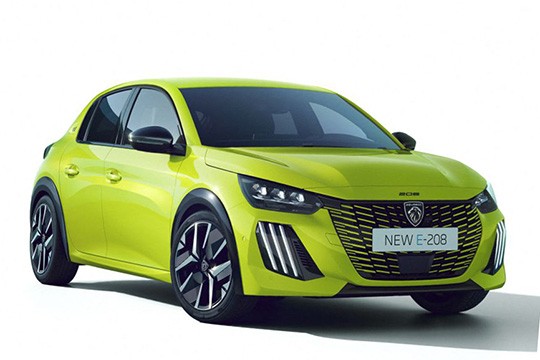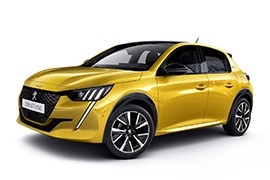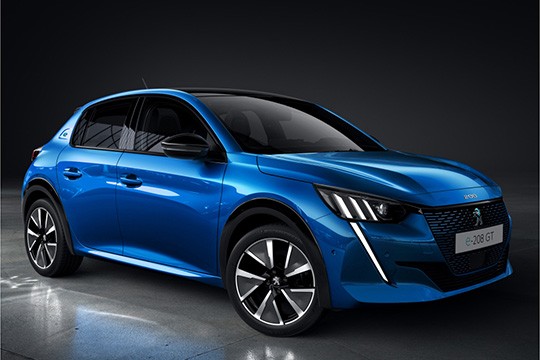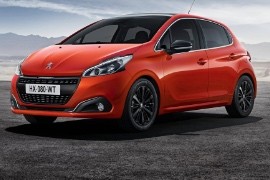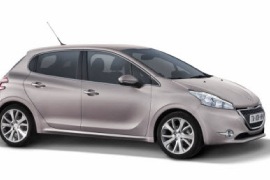PEUGEOT 208 5 doors Models/Series Timeline, Specifications & Photos
First production year: 2012
Engines: Electric, Gasoline, Diesel
Body style: Hatchback
Peugeot refreshed the entire lineup of the second generation of the 208 in July 2023, and the electric version was also heavily upgraded. It gained not only a new look but also a more powerful motor and a longer range.
Four decades after Peugeot launched the iconic 205 hatchback that sold in over 5 million units, the French automaker tried its best with the B-segment 208. Since the times were changed, the new model also came with an electric version. The automaker was not new to this game since it already tried it on the 106 Electrique supermini hatchback in 1995. Still, that model was a flop, with sales way under the target. But the carmaker learned its lesson, and when it brought the e-208 in 2019, it enjoyed great success.
The second generation of the 208 was a tremendous success for the French automaker. Even though it came in 2019, one year before the world pandemic situation, it was on top of its game and recovered quickly. It became the best-selling vehicle in its class for two years in a row, and the electron-powered version came on top of the B-segment in the electric category. Part of that success was the car's exterior design. As a result, Peugeot dared even more when it launched the 2023 model. At the front, instead of one vertical LED strip on each side of the front fascia, included three lines resembling three lion claws. After all, the lion was the brand's badge. Also, the grille was broader and extended on the lower bumper to the apron. The LED headlights lost their vertical illuminated slats and got three LEDs to illuminate the road. Depending on the trim level and color, the e-208 boasted wider tires and flared wheel arches. At the same time, at the back, a roof spoiler adorned the top of the tailgate. Furthermore, the taillights featured three horizontal LED lines instead of vertical ones, as in the 2019 model. As a distinct element for the electric version, Peugeot offered the e-208 with a choice of 16” and 17” light alloy wheels.
Peugeot engineers also improved the cabin. Like its predecessor, it featured a digital instrument cluster fronting the driver. In addition, a 10” touchscreen sat on top of the center stack for the infotainment system. Customers could buy the car with up to three charging ports (two at the front and one for the rear passengers) and a wireless charger for their mobile phones.
But the most significant upgrade was under the skin. While the automaker kept the same e-CMP platform with a front-wheel-drive setup, the motor was upgraded. Thus, instead of the older 134 HP (136 PS) unit, the automaker installed a 154 (156 PS) electric heart. The battery pack remained at the same value as its predecessor, but the range was extended to 400 km (249 miles) thanks to the new regenerative braking system. The automaker said that the battery pack could have been charged in approximately 25 minutes from 20% to 80% on a fast-charging station, while at a regular 7.5 kW, it took four hours and 40 minutes for the same refill.
Peugeot abandoned the idea of new names for each generation of its cars and continued the 208 with a second generation that appeared on the market in 2019, and it was only available with a five-door bodywork.
Over time, Peugeot used a specific naming system where the first number represented a size segment, the middle was always a zero, and the last was a generation. As a result, after the 205 came the 206, the 207, and the first generation of the 208, which appeared on the market in 2012. But seven years later, in 2019, the French car manufacturer introduced the second generation of the 208 instead of a logical 209 model. But customers accepted it, especially since the new model had nothing in common with its predecessor. Moreover, it was only available as a five-door hatchback: no three-door, no open-top, and no station wagons were planned for this generation. The French automaker kindly invited those who wanted a more spacious cabin to get the 2008 crossover, but there were no plans to satisfy those looking for a coupe or a drop-top version.
The 2019 208 came with a front fascia that looked different depending on the model and trim level. While the base model featured halogen headlights. As an option, the automaker offered LED daytime running lights sporting the three-claw signature design used for the rest of the carmaker’s range. The main grille looked like a shield and was adorned by a 3D pattern, while the apron featured a second air intake. The hood was like an Easter egg from the manufacturer since it featured a wide bulge on it, similar to the one installed on the legendary Peugeot 205 GTI from the 80s. From its profile, the B-segment vehicle featured sculptured doors on the lower side and enlarged rear quarter panels. Depending on the grade and options, the little Peugeot featured black plastic molds around the wheel arches, also a tribute to the former rally glory, the 205. Finally, at the back, Peugeot installed a raked-forward tailgate in a Kammback styling featuring a roof spoiler on its upper side.
Inside, the 208 impressed with its small steering wheel mounted low in front of the driver. At the same time, the instrument cluster was moved upwards compared to other vehicles in the segment and was available either with analog dials or with an LCD. Atop the center stack, all versions came fitted with a touchscreen for the infotainment system ranging between 5” and 10”, depending on the grade and options. For those looking for a sportier model, Peugeot installed a set of high-bolstered bucket seats at the front, while the base version featured a set of flat, yet ergonomic, ones. In the back, the split-folding (60/40) bench seat was suitable for two adults but too narrow for three on long trips. Behind them, the 311-liter (11 cu-ft.) trunk could be expanded to up to 1,100 liters (38.8 cu-ft.).
Under the hood, Peugeot installed a wide choice of diesel and gasoline engines and even an electric drivetrain. With a powerband offer ranging between 75 PS (74 hp) and 130 PS (128 hp), the car offered something for every budget.and 260 Nm of torque.
Peugeot introduced the second generation of its 208 B-segment hatchback in 2019, and besides the internal combustion engines' powered versions, it also brought an electric version, joining the movement for zero-emission vehicles.
Peugeot was not new to the electrification game since it already offered an electric version for the 1995 106, named Electrique. Even though it sold that model in just a little over 6,000 units in a few European countries, it was a start. But that model was mostly sold to help the carmaker's engineers understand what to do and how to develop an electric vehicle that could sell in big numbers. Thanks to new technologies and the evolution of the batteries, the e-208 had a much longer range than the previous 106 Electrique and better performance as well.
From the outside, the electron-powered version of the 208 didn't differ too much from its ICE-powered sibling. At the front, the car featured LED lights as standard that increased energy efficiency. The headlights flanked a grille that was mainly blocked since EVs didn't need a broad cooling area, unlike ICE-powered vehicles. In addition, the lower bumper was smoother and stripped from fog lights. Peugeot tried to maximize efficiency and installed aerodynamically studied alloy wheels, which featured blocked areas to minimize drag. In addition, it offered the vehicle with a set of low-resisting rolling tires. On the C-pillar, the automaker added the "e" badge just above the charging port on the left side of the vehicle. Finally, at the back, the B-segment hatchback featured LED taillights, with the specific Peugeot design featuring three vertical bars on each side.
Inside, the French automaker fitted the e-208 with technology, starting with the digital instrument cluster. In addition, a touchscreen filled the area above the center stack in a free-floating position. Fortunately, Peugeot left the turning knob in place for the volume, unlike other automakers that replaced it with touch-buttons that were difficult to use while driving. At the front, both passengers sat on bolstered seats, which were comfortable and made with some recycled materials. In the back, the split-folding bench could accommodate two occupants on long journeys or three for short jaunts. Since the automaker installed the battery pack under the rear bench seat and trunk floor, the luggage compartment was small but big enough for daily use.
Peugeot chose a 100 kW motor to power the little e-208, and the car was no slouch. It could reach 62 mph (100 kph) from a standstill in just a tick over eight seconds on its way to a capped top speed of 150 kph (93 mph). As for the range, the 50 kWh battery enabled the vehicle to run up to 340 km (211 miles) on a single charge.
Just three years after its launch, the Peugeot 208 was refreshed in 2015 featuring new engines and a new interior infotainment system. On top of that, new LED taillights have been added. The urban hatchback has enough personality to not be mistaken with some other vehicle.
A new sharper bumper was installed, with a wider grille and a thicker chrome finisher fully integrated into the bumper. On higher trim levels, the stamped chrome finisher on the grille gives it a 3D effect. The headlights are two-tone, with black and chrome masks, and are standard from the second trim level.
Inside the refreshed 208 there is the Peugeot i-Cockpit, an innovative arrangement of the instruments and controls. A new, 7” touch screen is installed for the infotainment unit and it is standard from the second trim level. It can be connected via Bluetooth and USB, and it can be paired even better via Peugeot Connect Apps. It also has MirrorScreen for Apple CarPlay and Android Auto.
Under the hood, Peugeot installed only Euro 6 engines. There is a wide choice of gasoline engines from 1.0-liter ones to 1.6-liters. The units with outputs under 110 hp are offered with a 5-speed manual transmission, while the 1.6-liter with 165 hp and 208 hp, respectively, are offered with a 6-speed manual. The 1.2-liter with 110 hp can be mated to a 6-speed automatic transmission. The diesel version is a 1.6-liter that comes with three power levels: 68 hp, 100 hp, and 120 hp, respectively.
PEUGEOT 208 5 doors 1.0L PureTech 5MT (68 HP)
PEUGEOT 208 5 doors 1.2 PureTech 6AT (110 HP)
PEUGEOT 208 5 doors 1.2L PureTech 5AT (82 HP)
PEUGEOT 208 5 doors 1.2L PureTech 5MT (110 HP)
PEUGEOT 208 5 doors 1.2L PureTech 5MT (82 HP)
The Peugeot 208 was unveiled in 2012. It replaced the older 207 and it came with an enhanced platform, better materials, and a bigger interior.
Peugeot had a relatively long history of building cars for the supermini segment. The biggest revolution in their family was the 1983 Peugeot 205. Following their naming tradition, it was followed by the 206 and the 207. If the 207 was considered more of an evolution over the 206, the 207 was a bigger step ahead. It was a car that was connected to the Internet.
The supermini car was designed with a more aggressive style. Everything on the front side was proportionally big. The grille included in the bumper, the headlights and the side air-intakes from the lower side of the apron almost covered all the front fascia. The grille above the bumper was minimal. The raked A-pillars looked almost like they were connected to the front wheel arches. A short greenhouse and a roof-spoiler completed the image. In the rear, the taillights featured an irregular design.
Inside, the car featured an unusual design with the instrument cluster floating on top of the dashboard and the 7” infotainment display installed above the center console. The French designers didn't go for a regular, simple look. They aimed high for a much younger generation.
Under the hood, the little Peugeot 208 was equipped with a choice of 8 engines: 3 diesel and 5 gasoline. Depending on the version, the 5- or 6-speed manual was fitted as standard. A robotized 5- or 6-speed gearbox was on the options list.
